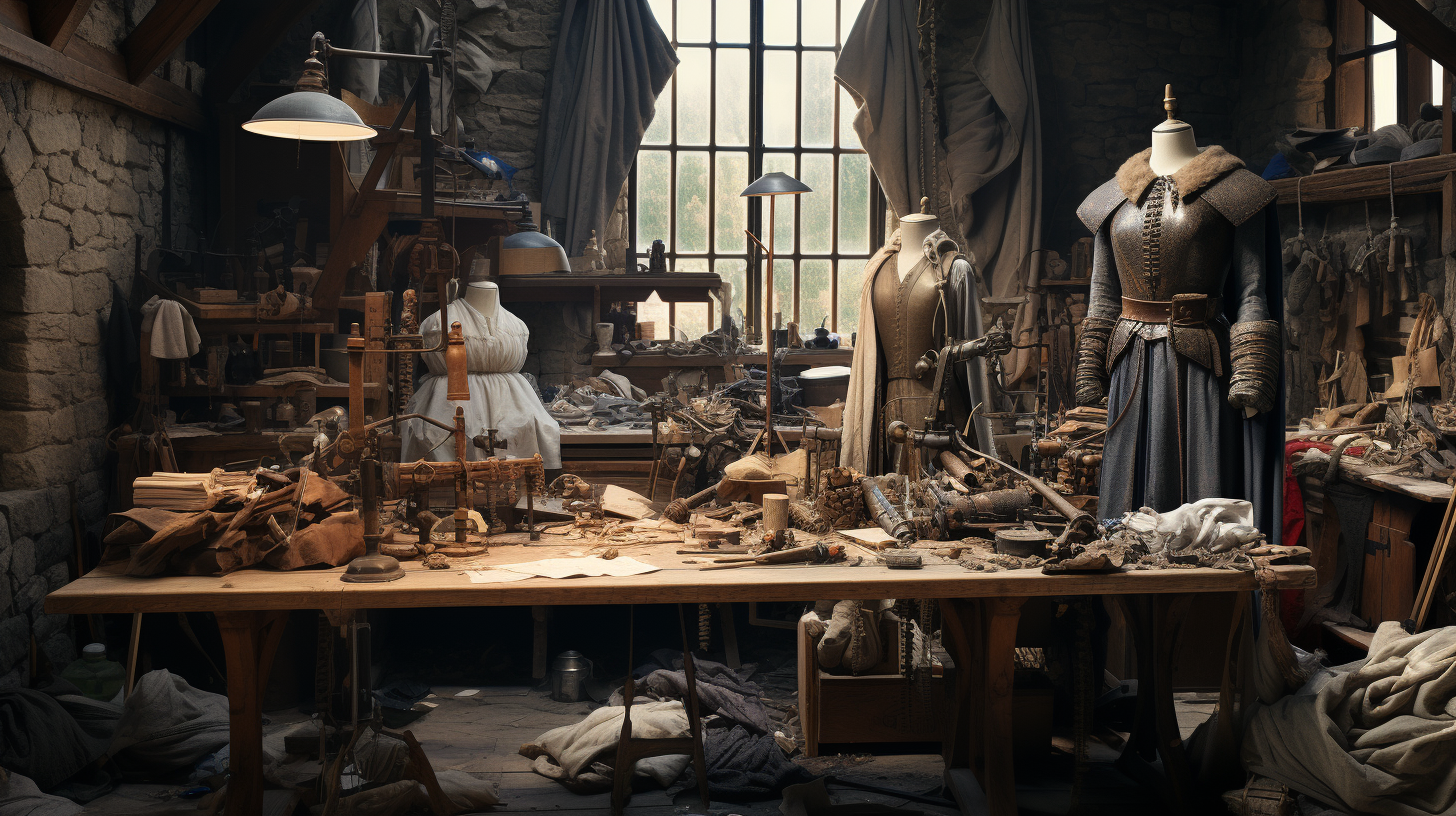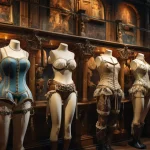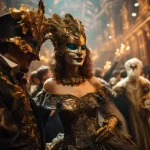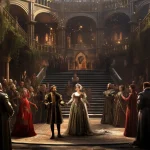
Unraveling the Threads of Majesty: Exploring the Fashion and Finery of Medieval Times
The Medieval Style Scene: A World Beyond Just Threads
Ah, the medieval times. They were more than just an era; they were a full-blown spectacle of style. Imagine walking down the streets back then – it’s like every day was a fashion show, but with a deeper meaning, you know? The threads people wore weren’t just cloth; they were like a billboard advertising who they were, what they stood for.
The Intricate Web of Medieval Wardrobe Wonders
Let’s dive into this sartorial safari, shall we? Medieval fashion, oh man, it was a complex beast. It wasn’t just about what looked good. Every piece of fabric, every color choice, every accessory had its own tale to tell. It was a mix of social standings, cultural vibes, and religious undertones. Imagine flipping through those ancient manuscripts; it’s like scrolling through an Instagram feed of the Middle Ages.
More Than Just Clothes: A Statement of Identity
Medieval garb was your ID card. It screamed your status from rooftops. The nobles? Oh, they strutted around like peacocks, draped in luxury. Every stitch screamed, “Look at me, I’m important!” And the common folk? Their gear was more about practicality, but it still had its own rustic charm. Studying these fashion trends is like time traveling, getting a front-row seat to the hopes, dreams, and lives of those medieval cats. 🌍👑📜
A Closer Look at Medieval Style: Deciphering the Dress Code
Medieval fashion – it’s like a puzzle waiting to be solved. Back in the day, your outfit was your resume; it told your whole story without you having to utter a single word. Those medieval folks, they had this whole language of fashion down pat, and every stitch, every fabric choice, it meant something.
The Manuscript Mirror: Reflecting Medieval Fashion
Now, to get the real scoop on medieval threads, you gotta check out those illuminated manuscripts. They’re like the fashion magazines of yesteryears. Take the “Book of Hours” from the 15th century – it’s a treasure trove of style intel. It’s fascinating to see how the nobles flaunted their wealth through extravagant threads – silk, velvet, fur. They were walking, talking status symbols. And the commoners? Their fashion was more about function, but it still had its own charm. Linen and wool were their go-tos.
Unraveling the Fabric of Medieval Fashion
Diving into these manuscripts is like having a backstage pass to a medieval runway show. You get to see the whole spectrum of styles, the craftsmanship that went into each piece. And let me tell you, those medieval designers, they were artists in their own right. It’s no wonder modern designers tip their hats to these old-school fashionistas. The level of detail, the creativity – it’s something else. It’s like fashion was their playground, and they were just swinging from the highest bars. 📜🎨👗
Medieval Fashion: More Than Just Threads, It Was a Social Statement
Back in medieval times, fashion was a whole different ball game. It wasn’t just about looking sharp or staying on trend. Nope, your outfit was a billboard, a loud and proud declaration of your spot in society’s hierarchy. It was a visual language, speaking volumes about who you were and where you stood.
The Nobility: Flaunting Their Status Through Fashion
Let’s talk about the big shots first – the nobility. Kings, queens, lords, and ladies, these folks were the A-listers of their era. They didn’t just dress to impress; they dressed to intimidate and dominate. Imagine the most exclusive designer brands today – that was the medieval nobility with their choice of fabrics. Silk, velvet, fur – these weren’t just materials; they were symbols of power, wealth, and influence. Every gown, every cloak, every piece they donned was a masterpiece, dripping with luxury.
Picture a king in his regal attire or a queen decked out for a coronation. These weren’t mere clothes; they were statements of unattainable grandeur. Embroidered with gold, studded with jewels, and stitched with the finest craftsmanship, these garments were the epitome of medieval high fashion. The colors were bold and striking, patterns intricate and mesmerizing. They were the trendsetters of their time, and their fashion choices were as much about politics as they were about aesthetics.
The Fashion Hierarchy: Reflecting Medieval Society
In this era, what you wore defined your role in the grand tapestry of society. It was more than fabric and thread; it was a symbol of identity and status. The nobility’s wardrobe choices were a clear declaration of their lofty status, an unmistakable sign of their place at the very top of the social ladder. Their attire was a visual feast, a mix of opulence, artistry, and sheer extravagance.
In summary, medieval fashion was a vivid reflection of social stratification. It was a world where your clothes spoke louder than your words, where the fabrics and designs you adorned dictated your place in the societal hierarchy. For the nobles, every garment was a testament to their wealth and power, a way to visually reinforce their dominant position in the medieval world. 🏰💎👑👗
Fabrics, Colors, and Accessories Used in Medieval Fashion
Wool was the primary fabric used in medieval fashion, regardless of social class. Its availability, affordability, and versatility made it the fabric of choice for clothing during this time. While wool provided warmth and durability, it could also be woven into intricate patterns and designs. Colors played a significant role in medieval fashion, with each hue carrying symbolic meanings. For example, purple represented royalty and power, while green symbolized fertility and new beginnings. Accessories were essential for both men and women, serving as statements of social status and personal style.Belts and jewelry, such as rings, necklaces, and brooches, were popular adornments. Badges, worn on clothing, held cultural and secular significance, representing pilgrimages or affiliations.
In addition to wool, other fabrics such as linen, silk, and velvet were also used in medieval fashion. Linen was often used for undergarments and lightweight garments, while silk and velvet were reserved for the nobility and clergy due to their luxurious nature. These fabrics added a touch of elegance and sophistication to the clothing. Silk, in particular, was highly prized for its smooth texture and vibrant sheen.
Colors played a significant role in medieval fashion, with each hue carrying its own symbolic meanings. Red, for example, symbolized passion and power, while blue represented purity and loyalty. The choice of color in medieval fashion was not arbitrary but a deliberate expression of identity and social status. The use of vibrant and richly saturated colors, often achieved through natural dyes, added visual interest and depth to the garments.
Accessories played a crucial role in medieval fashion, allowing individuals to personalize and enhance their outfits. Belts were not only functional but also decorative, often made of leather and embellished with metal buckles, gemstones, or intricate embroidery. They were worn around the waist and served to accentuate the silhouette while adding a touch of style. Jewelry, such as rings, necklaces, and brooches, added a sense of opulence and personal adornment. These accessories were often made of precious metals and adorned with gemstones, reflecting the wearer’s wealth and status.
Badges, another popular accessory, were worn on clothing to denote specific affiliations or achievements. These badges could represent membership in a guild, participation in a pilgrimage, or recognition of a notable accomplishment. For example, a pilgrim might wear a badge displaying the emblem of the shrine they had visited, while a knight might wear a badge denoting their allegiance to a particular lord or noble. These badges were often made of metal or enamel and served as a visual representation of the wearer’s identity and experiences.
Fabrics, Colors, and Accessories Used in Medieval Fashion
Unveiling the Fabric Palette of Medieval Elegance
Wool: A Fabric for All
In the enchanting world of medieval fashion, one fabric stood as a testament to its timeless appeal – wool. Regardless of one’s place in society, wool was the undisputed champion of textiles during this era. Its prevalence, affordability, and adaptability made it the fabric of choice for clothing. Wool served not only as a shield against the harsh elements but also as a canvas for weaving intricate patterns and designs that spoke volumes about the wearer’s style and creativity.
The very nature of wool allowed medieval fashion to thrive. Its warmth and durability made it the perfect choice for garments designed to withstand the rigors of daily life. Yet, it was the creative minds of medieval tailors and weavers that elevated wool from mere utility to an art form. The ability to weave intricate patterns and designs into woolen fabrics allowed individuals to express their individuality, even in a society defined by strict social hierarchies.
The Vivid Language of Colors
Colors: Beyond Aesthetics
In the medieval tapestry of fashion, colors weren’t just visual adornments; they carried profound symbolism. Each hue was a language in itself, weaving stories and communicating messages that transcended aesthetics. For example, purple, with its deep and regal hue, was more than a color; it was a symbol of royal might and power. Meanwhile, the verdant shade of green ventured into the realm of fertility and fresh beginnings.
Color choices in medieval fashion weren’t arbitrary; they were carefully calculated expressions of identity and social status. Natural dyes were harnessed to create vibrant and deeply saturated colors, adding layers of visual intrigue and depth to the garments. The use of these colors was not only a reflection of personal preferences but also a declaration of one’s place in the intricate web of medieval society.
Adorning Identity and Status
Accessories: Beyond Ornamentation
In the medieval world of fashion, accessories played a pivotal role in personalizing and elevating outfits. Belts, for instance, were not merely functional; they were also decorative statements. Crafted from leather and adorned with metal buckles, gemstones, or intricate embroidery, belts served both form and function. Worn around the waist, they accentuated the silhouette and added a touch of style to the ensemble.
Jewelry, including rings, necklaces, and brooches, served as expressions of opulence and personal adornment. These accessories, often made of precious metals and embellished with gemstones, were tangible reflections of an individual’s wealth and status. They weren’t just trinkets; they were statements of identity.
But beyond belts and jewelry, another fascinating accessory held cultural and secular significance – badges. These small but meaningful tokens were proudly worn on clothing, denoting specific affiliations or achievements. A badge could signify guild membership, a pilgrimage undertaken, or recognition of a notable accomplishment. Whether it was a pilgrim displaying the emblem of a revered shrine or a knight proudly wearing a badge symbolizing loyalty to a noble, these badges were more than ornaments. They were visual representations of a person’s identity and life experiences.
Exploring the Divine and Diverse Tapestry of Medieval Fashion
In the world of medieval fashion, one cannot escape the omnipresent influence of religion and culture. These forces were not mere spectators but active participants, shaping the very fabric of what people wore and how they adorned themselves. So, let’s don our metaphorical robes and mitres, and dive into the profound interplay between the divine and the diverse in medieval attire.
Religion’s Sartorial Symphony
Religion, like a mighty cathedral, cast its shadow upon every facet of medieval life, fashion being no exception. The garments worn by the clergy, including robes, cassocks, and mitres, were more than mere clothing; they were vessels of spirituality. Each garment served as a visible testament to the wearer’s devotion and commitment to their religious calling.
The hierarchy within the church was meticulously mirrored in the attire of its clergy. Bishops and archbishops, the high priests of the ecclesiastical realm, adorned themselves with elaborate robes and mitres bedecked with symbols of their exalted office. These vestments were not just garments; they were statements of spiritual authority.
Yet, the clergy’s sartorial influence extended far beyond their ranks. Religious symbols, such as crosses and crucifixes, were not hidden away but prominently displayed on garments. These symbols served as beacons of faith, proclaiming the wearer’s unwavering devotion to the divine. In a world where belief was paramount, one’s clothing spoke volumes about the state of their soul.
Cultural Variations: A Patchwork of Styles
Medieval Europe was a quilt of diverse cultures and traditions, each weaving its unique narrative into the fabric of fashion. Cultural norms and regional idiosyncrasies played a pivotal role in shaping clothing choices. The result? A vibrant tapestry of regional variations in medieval fashion.
Picture Italy, with its fashion heavily steeped in the legacy of the Roman Empire. The echoes of Rome reverberated through the garments of Italians, with styles that paid homage to the grandeur of antiquity. Meanwhile, in England, the influence of the Anglo-Saxons and Normans left indelible marks on fashion. The clothing choices in these regions bore the imprints of history, geography, and cultural exchange.
Geographical factors and climate also left their marks on regional attire. In the chillier climes of the north, layers of warm fabrics were a necessity, leading to distinctive styles. In contrast, the sun-kissed Mediterranean regions favored lighter and more breathable garments. The result? A diverse range of styles that mirrored the eclectic landscapes of medieval Europe.
Historical Events: Winds of Change in Fashion
As the pages of history turned, fashion was swept along in the currents of change. Wars, societal shifts, and encounters with different cultures molded fashion trends in profound ways. Take, for instance, the Crusades, those epic clashes between Christians and Muslims. Beyond the battlefield, these conflicts ushered in a cultural exchange that left an indelible mark on fashion.
Contact with the Middle East during the Crusades brought a treasure trove of new ideas and influences. Exotic fabrics, intricate patterns, and design elements from far-off lands found their way into medieval wardrobes. The allure of the unknown spurred a thirst for luxury goods, driving an expansion of international trade routes.
In this medieval world, fashion was more than mere adornment; it was a reflection of the dynamic interplay between religion, culture, and history. As we journey through this sartorial tapestry, we find that what people wore was not just clothing but a reflection of their beliefs, their identity, and the ever-evolving currents of their time.
Tracing the Shifting Currents of Medieval Fashion
In our quest to understand the ever-changing landscape of medieval fashion, we embark on a journey akin to exploring the diverse flavors of a vast and evolving culinary world. Medieval fashion, much like a rich tapestry, wove together a complex story of transformation over time. Let’s dive into this intricate tale, where clothing serves as the palette through which history and culture are painted.
Early Middle Ages: Simplicity and Functionality
In the early Middle Ages, often referred to as the Dark Ages, fashion was a reflection of the practical necessities of life. Simplicity was the guiding principle, and garments were designed primarily for functionality. Loose-fitting attire allowed for ease of movement, a crucial element in an era where physical labor and mobility were paramount.
Fabrics mirrored this practicality, with many left undyed and devoid of extravagant adornments. Resources were scarce, and extravagance was a luxury few could afford. The early medieval wardrobe was like a modest meal, focused on sustenance rather than elaborate flavors.
Middle Ages Unfold: The Renaissance of Style
As the Middle Ages unfolded, fashion experienced a renaissance of sorts, akin to the resurgence of artistic creativity in a culinary kitchen. Simplicity gave way to intricacy, and clothing became more tailored and refined. The Renaissance, a cultural revival, breathed new life into fashion, much as culinary traditions are rekindled and refined.
Inspired by the classical aesthetics of ancient Greece and Rome, fashion underwent a metamorphosis. Garments embraced structure and fit, accentuating the human form. Sumptuous fabrics, such as silk and velvet, became prominent, transforming fashion into a visual art form. It was no longer just about practicality; fashion became a means of expressing wealth and social status.
Cultural Fusion: An Exchange of Styles
Much like the fusion of diverse culinary traditions, trade and cultural exchanges played a pivotal role in shaping medieval fashion. These exchanges were like the spices that enriched the medieval fashion palate, introducing new ideas and styles from various regions and civilizations.
Consider the impact of the Crusades, epic journeys that bridged East and West. Similar to the introduction of exotic spices, Europeans encountered the opulent textiles and intricate designs of the Middle East. This cultural intermingling breathed new life into medieval fashion, infusing it with novel fabrics, patterns, and techniques. Silk, once a rare luxury, became more accessible, adding depth and richness to the sartorial landscape.
The desire for exotic goods and materials, ranging from silk to spices, fueled the expansion of international trade routes. This, in turn, facilitated the exchange of not only physical goods but also ideas and styles. Just as diverse culinary influences come together to create unique flavors, medieval fashion drew inspiration from the multitude of cultures it encountered.
In the grand realm of medieval fashion, we uncover a narrative that mirrors the evolution of human expression. It was a journey from simplicity to sophistication, from functionality to flamboyance, and from local traditions to global influences. Fashion, like a well-told story, satisfied not only the basic need for clothing but also the hunger for self-expression and identity in a world characterized by change and diversity.
Medieval Fashion Unveiled: A Journey Through Illuminated Manuscripts
Stepping Back in Time: Medieval Fashion Through Manuscripts
Illuminated manuscripts, a portal to the past, unveil the captivating world of medieval fashion. These remarkable relics provide us with a rare peek into the intricate details of clothing and accessories that once adorned the denizens of a bygone era. Among these treasures, “Philosophy Presenting the Seven Liberal Arts to Boethius” takes us on a visual odyssey through medieval fashion, where every brushstroke tells a story of artistry and imagination.
A Closer Look: “Philosophy Presenting the Seven Liberal Arts to Boethius”
But our journey doesn’t stop there. Enter the “Tres Riches Heures du Duc de Berry,” a masterpiece forged in the 15th century. Within its pages, we find scenes of everyday life, a tapestry of individuals from various social strata, each wearing their attire like a badge of identity. The manuscript is a symphony of colors, brushwork, and attention to detail, painting a vivid portrait of a time when fashion wasn’t just fabric, but a reflection of society’s tapestry.
Illuminating Medieval Style
Within these illuminated manuscripts lies a treasure trove of insights into medieval fashion. Men and women, their garments rich in detail, tell tales of fabrics, embellishments, and a sense of aesthetics that defined their era. These depictions offer more than just a visual feast; they offer a profound understanding of the fashion trends, social norms, and cultural influences that shaped medieval times. In these pages, we not only find history but a living testament to humanity’s unending fascination with style.
Unveiling Medieval Fashion: “Treasures of Gold and Silver Wire” Exhibition
Exploring the Guildhall Art Gallery’s Showcase of Medieval Artistry
For those yearning to step into the world of medieval fashion, London’s Guildhall Art Gallery presents an extraordinary exhibition titled “Treasures of Gold and Silver Wire.” This exhibition commemorates the 400th anniversary of The Worshipful Company of Gold and Silver Wyre Drawers, a trade guild with roots dating back to the Middle Ages. Within the gallery’s walls, over 200 artifacts await, including the illustrious Bacton Altar Cloth and the resplendent Queen Mary’s Coronation gown. These items serve as living testaments to the exquisite craftsmanship of medieval fashion, forging a tangible bridge to the past.
“Treasures of Gold and Silver Wire”: A Glimpse into Medieval Mastery
The exhibition “Treasures of Gold and Silver Wire” at the Guildhall Art Gallery beckons all who seek to witness firsthand the mastery and artistry woven into medieval fashion. This captivating showcase unveils over 200 objects, encompassing garments, accessories, and textiles, all meticulously crafted with the shimmering allure of gold and silver wire. These artifacts illuminate the intricate techniques and unparalleled skills of the Gold and Silver Wyre Drawers, a trade guild that left an indelible mark on the creation of sumptuous attire and accessories during the Middle Ages.
Among the array of remarkable relics stands the Bacton Altar Cloth, a rare survivor from the heart of medieval times. This intricately embroidered masterpiece stands as a testament to the virtuosity and artistry of the craftsmen behind it. Adorned with delicate gold and silver wire embroidery, it breathes life into scenes from the life of Christ. Its complexity in design and meticulous craftsmanship serves as an embodiment of the devotion to detail and artistic prowess inherent in medieval fashion.
Another crowning jewel of the exhibition is Queen Mary’s Coronation gown, a resplendent exemplar of medieval couture. Embellished with opulent gold and silver wire embroidery, this gown epitomizes the opulence and grandeur that adorned royalty during this epoch. The intricate patterns and impeccable craftsmanship displayed within the garment serve as a testament to the skill and artistry that breathed life into these regal ensembles.
By examining these artifacts up close and personal, visitors to the exhibition embark on a journey to discover the materials, techniques, and unyielding commitment to detail that defined medieval fashion. These objects provide not only a tangible link to days of yore but also a portal into the enchanting realm of medieval fashion, granting us a profound appreciation for the artisans whose hands meticulously crafted these exquisite garments.
Medieval Fashion: Accessorizing for Elegance and Identity
Enhancing Medieval Attire with Style and Significance
In the world of medieval fashion, accessories were not mere afterthoughts but integral elements that added finesse and conveyed social standing. Belts, jewelry, and badges were the silent narrators of a wearer’s identity and affiliations, seamlessly merging functionality with flair.
Belts: Beyond Utility, a Statement of Status
Belts, both functional and decorative, were indispensable accessories in medieval wardrobes. Crafted from sturdy leather and embellished with metal buckles, gemstones, or intricate embroidery, these belts did more than just hold garments in place. They were potent symbols of the wearer’s social status and personal taste. A nobleman’s belt would gleam with gold or silver, reflecting their elevated standing, while a commoner’s belt would exude simplicity and practicality.
Jewelry: The Subtle Art of Personal Expression
Medieval jewelry transcended gender boundaries, adorning both men and women with rings, necklaces, and brooches. These exquisite pieces, often fashioned from precious metals and bedecked with gemstones, injected a dash of opulence and individuality into medieval ensembles. The choice of jewelry was an artful reflection of social status and personal predilections. Noblewomen adorned themselves with pearl-laden necklaces or rings set with precious gems, while men displayed their elegance through tasteful adornments.
Badges: Symbols of Identity and Experience
The discreet yet meaningful world of medieval badges unfolded as small, decorative adornments on clothing. These badges were more than just embellishments; they conveyed cultural and secular significance. They marked affiliations, from guild memberships to pilgrimages to holy sites. Badges could also commemorate pivotal life events or serve as personal statements of identity. Each badge added an individualistic touch to medieval attire, allowing wearers to proudly exhibit their beliefs and experiences.
For instance, a pilgrim proudly wore a badge bearing the emblem of the shrine they had visited, such as the iconic scallop shell for those journeying to Santiago de Compostela. Similarly, knights displayed badges featuring their lord’s crest or the heraldic symbol of their family lineage. In this way, these unassuming accessories transformed into visual signposts of identity and allegiance, enabling individuals to narrate their beliefs and experiences through the fabric of their clothing.
The Timeless Influence of Medieval Fashion on the Modern World
Weaving the Threads of History into Contemporary Style
The enchantment of medieval fashion lives on, casting its spell on today’s fashion landscape. It’s a testament to the enduring legacy of medieval attire that continues to transcend time, leaving an indelible mark on contemporary designers and fashion aficionados alike.
Medieval Elements in Modern Garb
Elements of medieval clothing, like flowing sleeves, corsets, and intricate embroidery, have seamlessly woven themselves into the fabric of modern-day garments. These echoes of the past serve as a testament to the timeless allure of medieval fashion, a siren’s call that resonates through the ages and inspires fresh generations of designers and style enthusiasts.
Fashion’s Ongoing Love Affair with the Past
In the world of modern fashion, many designers find themselves drawn to the mystique of medieval fashion. They seamlessly incorporate these historical elements and motifs into their creations. Take, for example, the corset—a staple of medieval fashion—worn to sculpt the body and craft the perfect silhouette. Or the return of flowing sleeves, reminiscent of the ethereal and romantic touch that characterized medieval gowns, gracing contemporary designs with their timeless elegance.
A Glimpse into Medieval Accessories in Modern Times
The influence of medieval fashion doesn’t stop at clothing. It extends its captivating reach into the realm of accessories. Jewelry designers, for instance, pay homage to the medieval era with filigree work and gemstone settings reminiscent of the craftsmanship of yore. The delicate art of embroidery and intricate detailing evokes the spirit of medieval artisans, enriching modern creations with a touch of historical opulence.
Medieval Aesthetics in Popular Culture
The resonance of medieval fashion extends far beyond the realm of runways and red carpets. Popular culture, including movies, television shows, and fantasy novels, often draws inspiration from medieval aesthetics. These mediums transport audiences to distant times and places, immersing them in captivating worlds that pay homage to the majesty of medieval attire. The enduring popularity of events like Renaissance fairs and medieval-themed weddings further attests to the everlasting charm of medieval fashion.
In conclusion, medieval fashion is a rich tapestry of history, culture, and artistry. From the fabrics and colors to intricate accessories and the evolution of style, every facet narrates a compelling story. By exploring illuminated manuscripts, delving into the influence of religion and culture, and examining artifacts and exhibitions, we unravel the threads of splendor that defined medieval fashion. Whether through historical research or contemporary interpretations, the magic of medieval fashion continues to enthrall our imagination and shape the world of fashion today.








